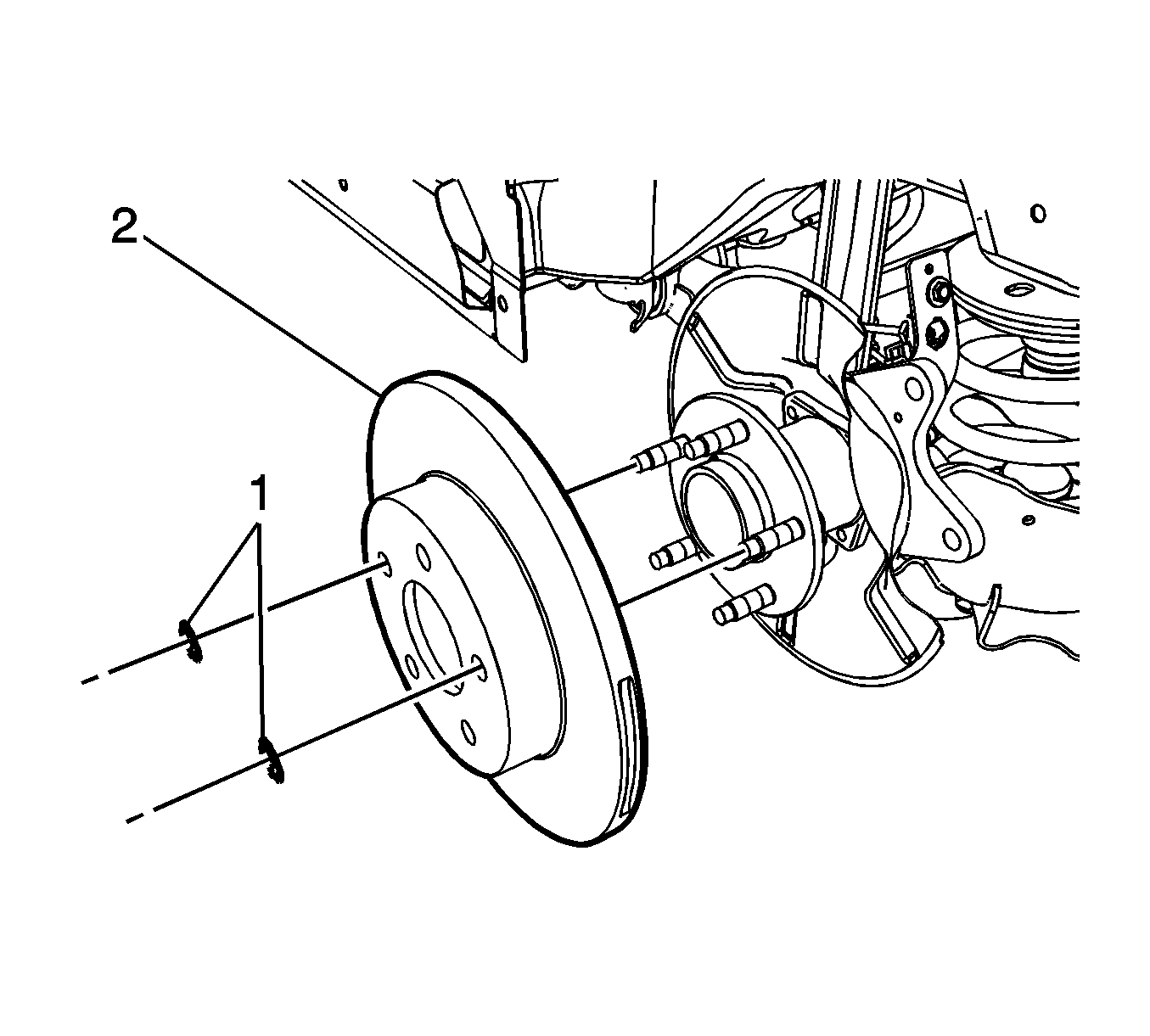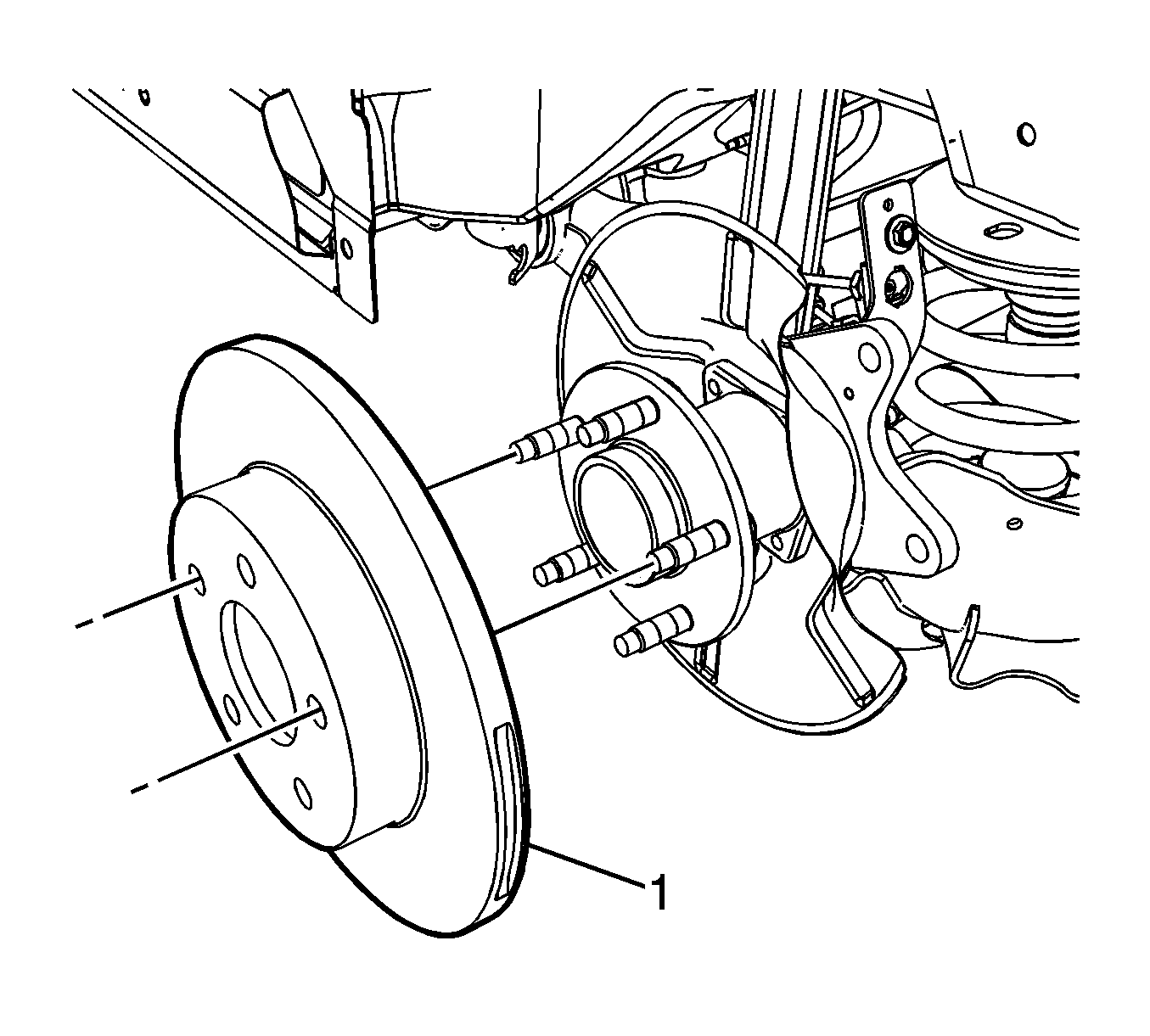Special Tools
| • | J 41013 Rotor Resurfacing Kit |
| • | J 42450-A Wheel Hub Resurfacing Kit |
Warning: Refer to Brake Dust Warning in the Preface section.
Removal Procedure
- Raise and support the vehicle. Refer to Lifting and Jacking the Vehicle.
- Remove the tire and wheel assembly. Refer to Tire and Wheel Removal and Installation.
- Install a large C-clamp over the body of the brake caliper with the C-clamp ends against the rear of the caliper body and against the outboard brake pad.
- Tighten the C-clamp just enough to compress the caliper piston 1 mm (0.039 in) of travel only.
- Remove the C-clamp from the caliper.
- Remove the brake caliper bracket bolts (1).
- Remove the brake caliper and bracket assembly and support with heavy mechanics wire or equivalent.
- Remove and discard the brake rotor retainers (1), if equipped.
- If installing the original brake rotor, mark the position of the rotor to the wheel hub.
- Remove the brake rotor (2).

Caution: When using a large C-clamp to compress a caliper piston into a caliper bore of a caliper equipped with an integral park brake mechanism, do not exceed more than 1 mm (0.039 in) of piston travel. Exceeding this amount of piston travel will cause damage to the internal adjusting mechanism and/or the integral park brake mechanism.
Caution: Support the brake caliper with heavy mechanic wire, or equivalent, whenever it is separated from its mount and the hydraulic flexible brake hose is still connected. Failure to support the caliper in this manner will cause the flexible brake hose to bear the weight of the caliper, which may cause damage to the brake hose and in turn may cause a brake fluid leak.

Installation Procedure
Note: Whenever the brake rotor has been separated from the hub/axle flange, any rust or contaminants must be cleaned from the hub/axle flange and the brake rotor mating surfaces. Failure to do this may result in excessive assembled lateral runout (LRO) of the brake rotor, which could lead to brake pulsation.
- Using the J 42450-A , thoroughly clean any rust or corrosion from the mating surface of the hub/axle flange.
- Using the J 41013 , thoroughly clean any rust or corrosion from the mating surface of the brake rotor.
- Inspect the mating surfaces of the hub/axle flange and the rotor to ensure there are no foreign particles or debris remaining.
- Install the brake rotor (1).
- If the brake rotor was removed and installed as part of a repair, measure the assembled LRO of the brake rotor. Refer to Brake Rotor Assembled Lateral Runout Measurement.
- If the brake rotor assembled LRO exceeds the specifications, bring the LRO to within specifications. Refer to Brake Rotor Assembled Lateral Runout Correction.
- Remove the support and position the brake caliper and bracket assembly to the wheel knuckle.
- Install the brake caliper bracket bolts (1).
- Install the tire and wheel assembly. Refer to Tire and Wheel Removal and Installation.
- Lower the vehicle.
- If the brake rotor was refinished, replaced, or if new disc brake pads were installed, burnish the pads and rotors. Refer to Brake Pad and Rotor Burnishing.

If installing the original brake rotor, align the rotor to the wheel hub as noted during rotor removal.

Caution: Refer to Fastener Caution in the Preface section.
Tighten
Tighten the bolts to 115 N·m (85 lb ft).
